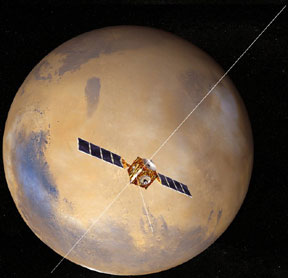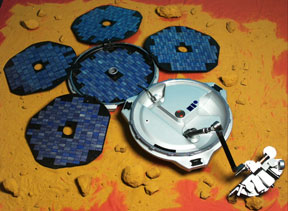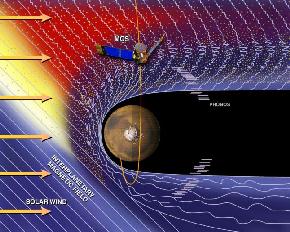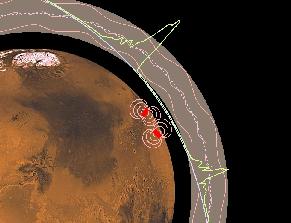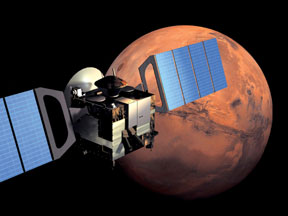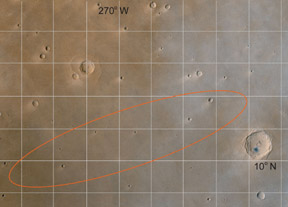Click on image for full size
Image courtesy the European Space Agency (ESA)
Mars Express Orbiter
The European Space Agency (ESA) launched a mission to Mars called "Mars Express" in June of 2003. The Mars Express spacecraft has two parts: an orbiter that will circle Mars for at least one Martian year (687 Earth days), and a lander named "Beagle 2" which is scheduled to touch down on the surface of the Red Planet on December 25, 2003. The Mars Express orbiter has seven major science instruments and experiments onboard the spacecraft. Those experiments will search for water, map the surface and subsurface of the planet, and measure the composition of the Martian atmosphere.
One of the orbiter's main purposes is to search for water beneath the surface of Mars using a radar system called MARSIS (Mars Advanced Radar for Subsurface and Ionospheric Sounding). Scientists are very curious as to whether there might be life on Mars, and water deposits are a good place to look for living creatures. The surface of Mars is too cold and dry for water, but there may be water underground in aquifers. The 40-meter (130-foot) long MARSIS antenna will bounce low-frequency radio waves off of Mars. This will help us determine the depth of dust deposits, the thickness of the sand in the large dune fields, and the subsurface structure of the planet to depths as great as a few kilometers (miles). If aquifers exist beneath the Martian surface, MARSIS should be able to detect them.
The High Resolution Stereo Camera (HRSC) will capture full color 3D images of the planet at a resolution of 10 meters (3.3 feet). Some areas will be imaged at a resolution of 2 meters (6 feet). The OMEGA Visible and Infrared Mineralogical Mapping Spectrometer will create a map of the mineral composition of the surface with a resolution of 100 meters (328 feet). Scientists hope to determine the iron content of the surface, the water content of the rocks and clay minerals, and the abundance of non-silicate materials such as carbonates and nitrates. OMEGA will also help scientists determine some aspects of the composition of the atmosphere.
The SPICAM Ultraviolet and Infrared Atmospheric Spectrometer will measure the abundance of atmospheric ozone and water vapor. The Planetary Fourier Spectrometer (PFS) will measure the amount and distribution of carbon dioxide (the main constituent of Mars' atmosphere), water, carbon monoxide, methane and formaldehyde. Over the course of the mission these instruments will determine the variation of the Martian atmosphere over time.
The ASPERA Energetic Neutral Atoms Analyzer will help scientists understand the upper atmosphere of Mars and its interaction with the solar wind. Mars has a weak magnetic field, so the solar wind is eroding its upper atmosphere. This may explain why Mars has such a thin atmosphere today, possibly having lost much of its atmosphere to space over time. ASPERA will measure ions, electrons and energetic neutral atoms in the outer atmosphere to reveal the numbers of oxygen and hydrogen atoms (the constituents of water) interacting with the solar wind and the regions of such interaction.
Radio signals from the spacecraft will be used to study the Red Planet via the Mars Radio Science Experiment (MaRS). Radio signals passing through the atmosphere as Mars Express circles behind Mars will help scientists understand the structure of the atmosphere and the ionosphere. Slight variations in the vehicle's orbit, which appear as tiny changes in the arrival times of radio signals, will help us map Mars' gravity field and thus provide a better picture of the planet's interior. Radio signals reflected from the surface of Mars will provide a glimpse into the roughness of the surface at various locations.


